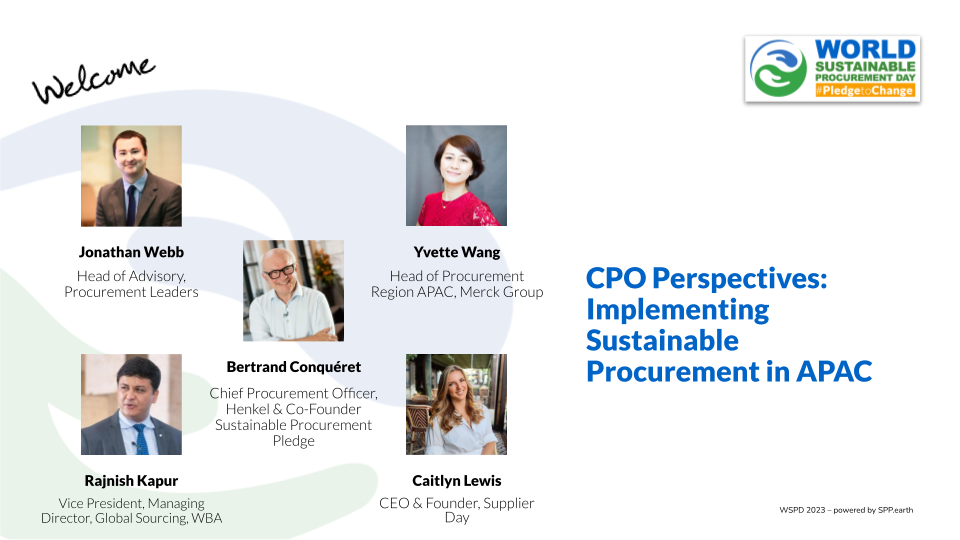WSPD 2023 brought together top CPOs and industry experts from across the globe in a 24-hour-long event, designed to empower and equip Procurement Practitioners with knowledge, best practices, and practical solutions to Sustainable Procurement challenges that need to be tackled NOW.
Broadcasting in 4 different regions, – APAC, AMESA, Europe/UK & the Americas – each session was curated to address the most prominent regional issues surrounding Sustainability in Procurement.
Check out all of the WSPD 2023 sessions here
Kickstarting WSPD 2023 in the Americas, regional CPOs and Thought Leaders;
Bertrand Conquéret (CPO Henkel and Co-Founder SPP)
Jonathan Webb (Head of Advisory at Procurement Leaders)
Yvette Wang (Head of Procurement Region APAC at Merck Group)
and Rajnish Kapur (Vice President, Managing Director, WBA Global Sourcing at Walgreens Boots Alliance)
were invited to participate in the first session of the region ‘CPO Perspectives: Implementing Sustainable Practises in APAC’, moderated by Caitlyn Lewis (CEO, Supplier Day)
This panel discussion highlighted the challenges, opportunities and priorities facing sustainable procurement practices in APAC. It was an opportunity for the panellists, as experts and practitioners, to share practical insights into what’s important for the region, what the key priorities are for CPOs, and how procurement practitioners can take action today, in their own organisations.
Here are 4 key insights that our speakers provided across the session:
There is no “one approach” with APAC
Diving into the session, one of the first things that was highlighted was the immense size and diversity of the APAC region. Yvette Wang was the first to explain that “In reality, APAC is actually a lot of regions”. Encompassed within the term ‘APAC’ there exists many different cultures, languages, and values all of which need to be taken into account when discussing sustainability.
Jonathan Webb also spoke on the large scale of the APAC region, informing attendees that “60% of the world’s population is in Asia Pacific”, as well as many “big and impactful economies”, resulting in organisations having to deal with often “complex and fragmented marketplaces”.
Commenting on the difference between countries within the region, referencing Japan, India and Australia, Yvette firmly explained that procurement processes, especially surrounding sustainability, cannot be dealt with in the same manner as the western countries. Instead, it is crucial to understand the local culture and government, so that Procurement can “operate in a local context” to develop a successful strategy for sustainability and supply chain transparency.
“There is so much diversity within this region” – Yvette Wang
She continued to discuss how each region/country within APAC faces different challenges when it comes to sustainability, emphasising that “it is difficult to implement one initiative that can solve everything within the region”. Instead, she recommends that Procurement strategies and initiatives should be specific to the location: “understanding your market is very important”.
Jonathan additionally mentioned how Procurement is often led to believe that APAC is behind other regions, such as AMESA and the Americas, when it comes to implementing sustainable practices. He speaks about how this is not true, but instead, APAC tends to deal with different circumstances than other parts of the world, such as extreme weather conditions that severely affect their supply chain. He mirrors Yvette’s recommendation that Procurement should be “accommodating the culture and country they are sourcing from”.
Advising global organisations looking to coordinate their carbon efforts around the world and APAC, Yvette encourages procurement professionals to “be flexible” and adopt “a global approach”. Determine how you “are going to deliver something on a global scale” and then be “adaptive and flexible about how you do that in regional parts”.
Transparency and Collaboration is Key
‘Transparency’ and ‘Collaboration’ were some of the most repeated words across the entire session, with each panellist speaking on its importance not just within APAC, but as fundamental goals for organisations and their Procurement functions.
Bertrand Conquéret spoke highly about “developing the power of collaboration”, reflecting on his own experience of co-founding The Sustainable Procurement Pledge as a medium to “build up that aspiration to harbour the power of collaboration across the entire profession of procurement”.
“I have experienced the power of collaboration” – Bertrand Conquéret
By striving for transparency and collaboration, Bertrand mentions how it can guide and provide solutions to existing sustainability challenges. According to him, building harmonised and standard processes, finding accurate data, and recognising that you are not alone, are some of the main components of the “true journey” procurement professionals should be making towards sustainability.
“Without transparency, you cannot collaborate and without collaboration, you’re not going to achieve any transparency” – Caitlyn Lewis
Yvette equally states the importance of transparency within the region, speaking of a “transparency mindset” that needs to be developed within different markets. Ostensibly, “APAC has different levels of understanding and engagement for transparency” Yuvette states, which is why organisations need to engage and collaborate with their suppliers, creating a more transparent supply chain. This aids organisations across the world to better track their Scope 3 emissions, encourage a “collective effort” towards achieving sustainability, and champion positive change for their entire supply chain network.
“[we] have to collaborate with our suppliers, with our peer companies, with our customers and our communities to make this happen” – Yvette Wang
Caitlyn Lewis also speaks of the power of collaboration and transparency as a way for Procurement to stay ahead of the game. Transparency around what problems/consequences organisations can face and “collaborate ahead of time”, implementing preventative solutions that can mitigate overall industry risk.
Approach Sustainability with Your Suppliers
While addressing any topics, from Transparency and Collaboration to Diversity & Inclusion, our speakers repeatedly spoke of the importance of measuring/assessing suppliers with processes such as the EcoVardis assessment and regular auditing.
Rajnish Kapur mentioned how his suppliers go through a “rigorous onboarding process”, and are continuously monitored to ensure they are meeting their social and environmental standards. “Our suppliers are aware of and compliant with all our standards” he states, going further to announce that “we will not work with suppliers who do not consistently comply with rigorous ethical standards”.
“Complying with the requirement of ethical standards and adhering to a supplier code of conduct are absolutely non-negotiable for us” – Rajnish Kapur
Bertrand also spoke of using assessment and auditing within Tsf to leverage the power of collaboration and create a foundation of transparency: “I strongly believe in the assessment processes.’ He similarly reassures other procurement professionals that “we are all into the same agenda”, no matter if they are working in the private or public field. Therefore when identifying suitable suppliers for collaboration, “[you] do not need to reinvest the wheel”. Instead, he recommends adopting the standards and processes that other organisations have successfully implemented and creating a culture that mobilises teams to be inclusive, diverse, engaging, and responsible.
“This is the next step which can be, not easily, but managed with heart, with head, and with hand” – Bertrand Conquéret
When asked how Procurement can manage their suppliers’ sustainability performances, Yvette stated that “sustainability is not an add-on” but instead a requirement that must be fulfilled. For this, new suppliers need to present their existing performance, via EcoVardis assessments, as well as demonstrate an ability to handle the requirements of ongoing assessments and audits. With hard criteria to meet, suppliers need to show that they either have or are working on initiatives to reduce their carbon emissions.
“I believe we have vast opportunities in our supply network that they [suppliers] can bring value to solve our problem” – Yvette Wang
Productivity with Sustainability
Procurement is truly at the forefront of implementing sustainability and sustainable practices within organisations across the APAC region. From engaging with suppliers to adopting new technology solutions, our panellists highlighted many things that Procurement could do to ensure sustainability is well and truly embedded within their organisation.
“[There are] opportunities for the procurement function to take a lead and help the business guide through the complexities of the different sustainability and different risks in this region” – Jonathan Webb
When speaking on the balance procurement teams need to strike between cost-saving and sustainability, Jonathan mentions that it is “critically important for businesses to communicate and understand the pricing difference” between more sustainable options. Stating that “cost-saving is unachievable”, he believed that it is better to look for alternatives that provide “positive contributions” in the long run. This is a responsibility that he places on Procurement, stating that they “need to evidence and advocate for the potential of the long-term cost reduction of more sustainable supplies”.
“Sustainable alternatives have the potential to lower costs in the longer term” – Jonathan Webb
Bertrand mentions that to ensure that Procurement can maintain sustainable practices as the default behaviour, they must deliver a “clear understanding of their strategy and commitment” as well as KPIs and targets to their Procurement professionals: “It is a Mindset. It is a Journey”
He continues to speak on this topic, stating that Procurement functions looking to achieve their goals of transparency within their supply chain should encourage their Procurement professionals to “embed [sustainability] into their daily lives”, and provide compensation/benefits to those who are looking to achieve this. By bringing sustainability into the role description, evaluating leadership performance, and assessing where they are on their targets, Procurement can “contribute to developing a business strategy for the company”, with sustainability and responsible sourcing intrinsically associated with it.
“We [Procurement] have the opportunity to make the first step” – Bertrand Conquéret
Check out the full panel discussion below to hear more of the panellist’s key insights about implementing sustainable procurement in APAC.



